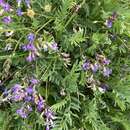Comprehensive Description
(
Inglês
)
fornecido por North American Flora
Homalobus bourgovii (A. Gray) Rydb. Mem. N. Y
Bot. Gard. 1; 247. 1900.
Astragalus Bourgovii A. Gray, Proc. Am. Acad. 6: 227. 1864. Tragacantha Bourgovii Kuntze, Rev. Gen. 943. 1891.
A perennial, with a cespitose caudex; stem decumbent to erect, 2-30 cm. high; leaves 3-10 cm. long, ascending or erect; stipules lanceolate or the lower ovate, connate, 1-3 cm. long; leaflets narrowly lance-oblong to oval, 3-20 mm. long, 1-6 mm. wide, strigose on both sides or nearly glabrate above, acute to rounded at the apex; peduncles 4-10 cm. long; racemes at first short, in age elongate, 2-8 cm. long; bracts subulate, 1-2 mm. long, black-hairy; calyx blackhairy, the tube 2.5-3 mm. long, the teeth subulate, 1-2 mm. long; corolla dark-purple; banner 7-9 mm. long, slightly notched; wings 6-8 mm. long, the blade obliquely obovate, with a large basal auricle, slightly longer than the claws; blade of the keel-petals broadly lunate, with a rounded tip and a rounded basal auricle; pod short-stipitate, lance-oblong, flat, 10-15 mm. long, 3-3.5 mm. broad, acute, black-hairy; seeds dark-brown, oblong-reniform, 3 mm. long, 2 mm. wide.
Type locality: Rocky Mountains, on the British Boundary. Distribution: Alberta, British Columbia, Idaho, and Montana.
- citação bibliográfica
- Per Axel Rydberg. 1919. (ROSALES); FABACEAE; PSORALEAE. North American flora. vol 24(1). New York Botanical Garden, New York, NY
Physical Description
(
Inglês
)
fornecido por USDA PLANTS text
Perennial, Herbs, Stems woody below, or from woody crown or caudex, Taproot present, Nodules present, Stems very short, acaulescent or subacaulescent, Stems or branches arching, spreading or decumbent, Stems prostrate, trailing, or mat forming, Stems less tha n 1 m tall, Stems solid, Stems or young twigs sparsely to densely hairy, Leaves alternate, Leaves petiolate, Stipules conspicuous, Stipules membranous or chartaceous, Stipules persistent, Stipules connate to each other, forming a tuber or sheath, Leaves compound, Leaves odd pinnate, Leaf or leaflet margins entire, Leaflets opposite, Leaflets 10-many, Leaves hairy on one or both surfaces, Inflorescences racemes, Inflorescence axillary, Bracts very small, absent or caducous, Flowers zygomorphic, Calyx 5-lobed, Calyx glabrous, Petals separate, Corolla papilionaceous, Petals clawed, Petals blue, lavander to purple, or violet, Petals bicolored or with red, purple or yellow streaks or spots, Banner petal narrow or oblanceolate, Wing petals narrow, oblanceolate to oblong, Wing tips obtuse or rounded, Keel petals auriculate, spurred, or gibbous, Keel tips obtuse or rounded, not beaked, Stamens 9-10, Stamens diadelphous, 9 united, 1 free, Filaments glabrous, Style terete, Style persi stent in fruit, Fruit a legume, Fruit stipitate, Fruit unilocular, Fruit freely dehiscent, Fruit oblong or ellipsoidal, Fruit or valves persistent on stem, Fruit exserted from calyx, Fruit beaked, Fruit hairy, Fruit 2-seeded, Fruit 3-10 seeded, Seeds cordiform, mit-shaped, notched at one end, Seed surface smooth, Seeds olive, brown, or black.

